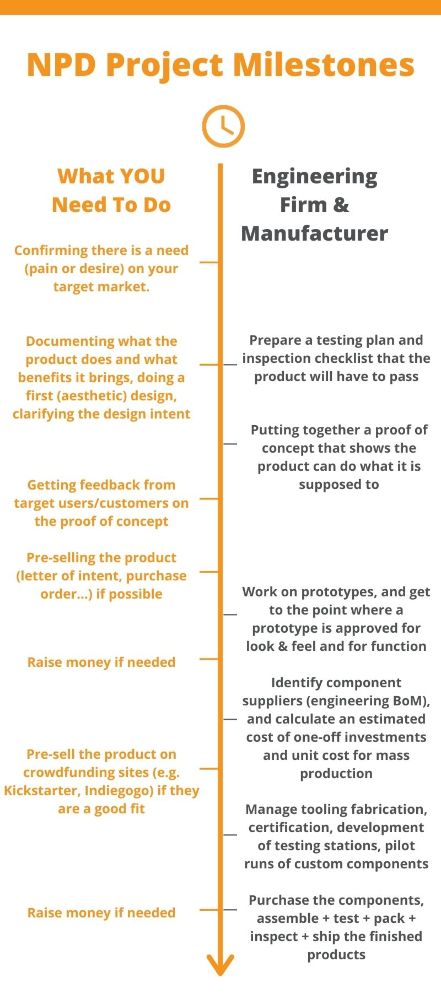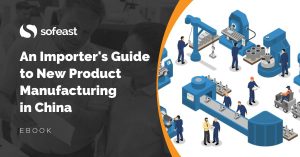Many people contact us with an idea for a new product they want to develop… and nothing else. We usually explain that they are not ready for talking to China-based manufacturers until they have done more ‘homework’.
Over the weekend, I listened to an episode of the Predictable Design Podcast (The Importance of Defining Project Milestones), which covered the main steps every new company that wants to manufacture a new physical product has to go through. It is a great listen.
It inspired me to put together an overview of “who has to do what”, as you can see below:
(Obviously, it doesn’t include many support activities, such as working with a lawyer to set the right expectations, etc.)
Breaking down the process of going from new product design to mass production
Let’s go through the typical steps from new product design to production.
Step 1: Confirming there will probably be market demand (by the founders)
Talking to potential customers and decision-makers is often quite insightful. It is usually the right first step. Many products are launched and don’t meet any demand. The entire project is an enormous waste of time and money. That’s an important risk to avoid.
Step 2: Putting some thoughts into what a solution would look like, how it would work, etc. (by the founders)
If you are not motivated enough to spend the time to educate yourself on the technologies and materials related to the product both manufacturers and investors will see that as a red flag!
I wrote before about what to include in your brief to designers. Working on the aesthetic design, without going into all the small details, usually makes sense at this stage.
Step 3: Translating performance needs into more objective requirements
Let’s say you want to develop an e-bike. Instead of “it can go fast”, write “it can get up to 25 mph on flat terrain”. Instead of “it can last a long day trip”, write “battery can last more than 5 hours if the bike keeps going at 15 mph on flat terrain with no stop and a passenger of 150 Lbs”.
This is a critical link between the benefit to the user and the information engineers need to work with.
Step 4: Building a ‘proof of concept’
People who think of a new product want to have a prototype as early as possible. It makes sense. But, if you can’t find a product that is relatively similar in terms of functionality, the first step is to make a crude prototype that will “do the job”. One purpose is to learn from it and, if needed, to do a few iterations in order to improve the design.
Step 5: Again, confirming there will be demand for such a product, and if possible pre-selling that product (by the founders)
Another purpose of the ‘proof of concept’ is to collect feedback from potential customers. You really want to minimize the risk of bringing something to market and find out that your target customers don’t see any value in it. You also want to get as much constructive feedback as possible and improve the design.
Step 6: Building prototypes and testing them as per steps 2 & 3, and confirm the technical feasibility
Now is the time to work on prototypes. For a product relatively complex, it may take 3-8 iterations before a look-alike and work-alike prototype can be confirmed. (And remember to do testing as per step 2.)
All this can be handled by a design firm. Many times, involving a Chinese manufacturer too early is a mistake.
On your side, you really need to have a clear and documented quality standard by this step.
Step 6 bis: Identification of suppliers, which leads to estimates of pricing, MOQ, lead times, etc.
To build the prototypes, parts need to be procured. As the engineers get closer to a final prototype, it is important to get those parts from qualified suppliers (i.e. capable of mass production with high quality). The end deliverable is the engineering BOM.
Step 7: Again, pre-sell the product if possible, for example on Kickstarter (driven by the founders)
I get back to this again and again. As much as possible, you need to sell your new product before it is fully produced!
Step 8: Handle all the pre-production work (tooling, certifications, process engineering, pilot runs, reliability testing…)
This is the step when you really need to be working with the company that will manufacture the product. (There are many things you might want to check in order to vet a manufacturer, and I wrote an entire series of articles on that topic and also created podcast episodes about this – here is episode 1 of that series.)
You are also encouraged to be involved in these steps, but a supplier that has done this many times in the past will save you time and headaches.
Step 9: Mass production
This is all handled by the manufacturer you have chosen. And, in the absence of strong assurance, you need to do quality inspections on at least the first few batches.
—
Following these steps from new product design to production is hard work. But will increase your chances of bringing your new product from design to production and to market successfully. That’s also the way investors look at it, and that’s why they look at many of these steps as significant milestones.
Are you designing, or developing a new product that will be manufactured in China?
Sofeast has created An Importer’s Guide to New Product Manufacturing in China for entrepreneurs, hardware startups, and SMEs which gives you advance warning about the 3 most common pitfalls that can catch you out, and the best practices that the ‘large companies’ follow that YOU can adopt for a successful project.
It includes:
- The 3 deadly mistakes that will hurt your ability to manufacture a new product in China effectively
- Assessing if you’re China-ready
- How to define an informed strategy and a realistic plan
- How to structure your supply chain on a solid foundation
- How to set the right expectations from the start
- How to get the design and engineering right
Just hit the button below to get your copy (please note, this will direct you to my company Sofeast.com):


